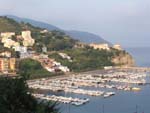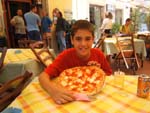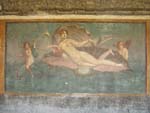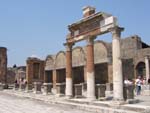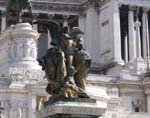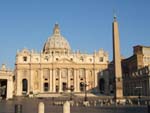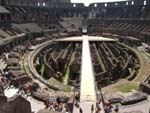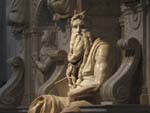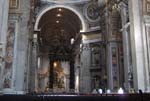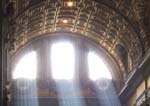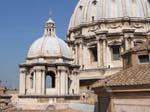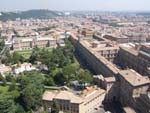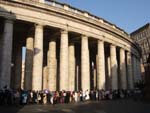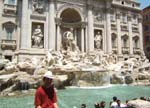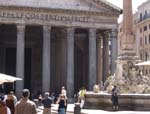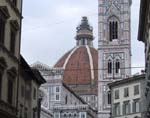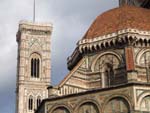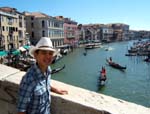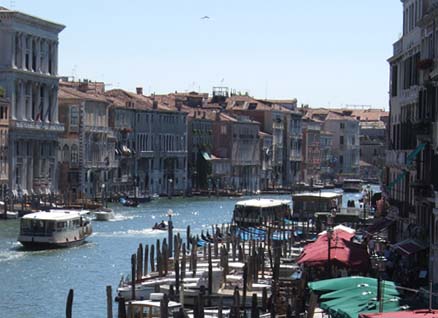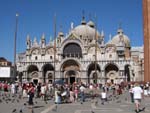  Italy It's been 24 hours of travel since we left Corfu. We arrived in Italy about 9 am and traveled the day with Laura, a nursing student from Baltimore. She's based in Rome and returning from a trip to Athens. After 10 hours on the ferry we caught a 3-hour bus to Napoli, bid Laura farewell, rode a 1-hour train to Battipaglia, and transferred to a 1-hour train to Agropoli. Opps! Sorry, we were told to board the train to Agropoli but it didn't stop until 2 stations past Agropoli. We took a slow train 30 minutes back to Agropoli. Hopefully Laura had better luck getting to Rome. So why are we here? Frank says a local pizzeria has the second best pizza he's ever eaten. We make the mistake of accepting a taxi driver's 'help' locating a hotel and he tries to sell us everything from a rental car and scooter to a beachfront hotel we didn't want. To make matters worse, Frank's second-favorite pizza place is now owned by someone less friendly then the man Frank knew. Frank and Kevin give it a try anyway and discover that the pizza is no longer on the World's 10 Greatest Pizzas list. However, they didn't arrive at this decision until the pizza was completely gone.
While Frank and Kevin relax and test local pizzas, I travel north to Paestum. It was founded by the Greeks as Poseidonia around 600 BC, occupied by the Lucans from 400 BC to 273 BC, then rededicated as Paestum by the Romans. As the Roman Empire declined so did Paestum. The area also became marshy, giving residents more reason to move away. Forest moved in and protected the site until its discovery in 1752. The Temple of Athena was built on the highest point on the site around 500 BC in the early Doric style with some inner Ionic columns thrown in. The Temple of Hera II (or Poseidon, or Apollo, depending on who you read), was built around 450 BC in the classical Doric style. This is about the same time the Parthenon was built in Athens.
It was an easy train ride north from Agropoli to Pompeii, between Salerno and Napoli. The city was founded by the Greeks in the 7th century BC, taken by the Samnites in the 5th century BC, and became a Roman colony in 80 BC. A maritime trading town and resort, Pompeii was seriously damaged by an earthquake in 63 AD. The eruption of Vesuvius in 79 AD occurred before reconstruction was complete. Many sources refer inaccurately to the 'destruction' of Pompeii. It wasn't destroyed, it was just buried beneath ash and cinders that accompanied the eruption. What was bad luck for the 2,000 that died is good luck for us. Excavations of the city afford a rare glimpse into the everyday lives of first century Romans.
We entered through the gate nearest town, which turned out to be the back door of sorts. That worked well, taking us first through neighborhoods far away from the main tour area. The House of Marine Venus has beautifully preserved frescoes, the Pistrinum (bakery) has that fresh-baked bread smell, and you can still hear the market hustle outside the Macellum. Behind bars near the Foros, casts of eruption victims sit alongside shelves of amphorae. Roma
(Rome) Our train arrived at Roma-Termini and it was an easy connection to the metro downstairs. Bed & Breakfast a Roma was just a few minutes' walk from the metro stop, less than half a kilometer from Vatican City. It was an easy walk to Piazza San Pietro, a truly amazing sight. Tourists were huddled in shady spots trying to escape the afternoon's 95º heat. The line to enter St Peter's wasn't very long but Frank and Kevin were in short pants, too short for the Vatican dress code. We walked to Largo di Torre Argentina and Frank and Kevin rested while I made a quick trip to the Monumento Nazionale a Vittorio Emanuele II. It commemorates Italy's independence in 1870 and Victor Emmanuel II, the first king of a united Italy.
Our second day in Rome started at the Colosseum. Rather than spend time waiting in line to purchase tickets there, we walked up the hill to Palatino, first among the historic seven hills of Rome. There was no line to purchase tickets, no waiting to get in, and the ticket would be good for the Colosseum, too. Palaces of emperors and aristocrats once graced the Palatine and the present layout comes from Domitian's reign (AD 81-96). Although interpretive information is lacking, the ruins are impressive and an overlook provides an elevated view of the old Roman Forum. A short walk and no waiting in line found us in the Colosseum, the largest closed structure left from Roman antiquity. The emperor Vespasian started construction in AD 72 on the site of Nero's colossal statue, returning land to public use that Nero had taken for himself. Although much is said of the violent games held here, it was also used for other non-violent entertainment.
Up the hill from the Colosseum is one of the oldest churches in Rome, San Pietro in Vincoli (St Peter in Chains). In addition to the chains traditionally believed to have restrained St Peter during his imprisonment, the church is home to the monument of Pope Julius II conceived by Michelangelo. The figure of Moses is one of his greatest sculptures, complete with horns (a mistake in translating Biblical text). Early morning is a good time to visit St Peter's, both because of favorable light and the lack of crowds at opening time (7 am). Originally built on the historical site of St Peter's tomb, the AD 326 church was in poor condition by the mid-1400s. Remains of the first church walls, sculpture, and art can be found in the basement along with tombs of many popes (including the last) and St Peter. Construction of the new church started in 1506, involved many architects and artists, and wasn't completed for several hundred years. Michelangelo took over church design in 1547 but didn't live to see his central dome completed. Below the dome is the bronze Papal altar with a 95-foot baldacchino (canopy) by Bernini.
The roof is accessed from the east end of the south aisle, near the Gregorian Chapel. A lift is available but the stairs don't take very long. The roof affords great views of the dome and southern skyline. A narrow staircase climbs the space between the inner and outer domes to the lantern with views of Vatican City and Rome. The descent takes you back by way of the inner dome and lets you look down into St Peter's from above. Day 4 in the Eternal City and Frank and I walked down to St Peter's for a quiet morning in the basilica. Much to our surprise, a large crowd was growing outside the barricaded square. At first we thought it was tourists waiting to claim spots in the piazza for the Pope's Wednesday blessing. The piazza opened late and some people ran toward the line into St Peter's (mentally picture nuns in habit running). It turns out that today is the holiday of Saints Peter and Paul and the Pope is scheduled to lead mass at 8 am. Rome is closed today. Fontana di Trevi (Trevi Fountain) was open and running, as we and about 10,000 other tourists discovered.
The Pantheon was originally dedicated in 27 BC to the Greek planetary gods and since then has been used for parts, abandoned, and restored. Bronze from the porch roof was used to cast Bernini's baldacchino in St Peter's. It was dedicated to the Virgin and all Christian martyrs on November 1, 609, the first feast of All Saints. The Castel Sant' Angelo is a few blocks east of St Peter's and was started by Hadrian about AD 135 as a mausoleum. It was later incorporated into Rome's defenses and in 1277 linked to the Vatican palaces with the passetto wall. Popes were able to escape the Vatican during attacks and take refuge behind the castle walls. The Ponte Sant' Angelo crosses the Tibur in front of the castle and was also built by Hadrian. Statues lining the bridge date from 1463 to 1668 and include 10 figures carved to Bernini's specifications by his pupils. After one last walk around St Peter's we're on the slow train to Firenze. The ride takes us through the scenic midsection of Italy and into Tuscany with its old hilltop villages and cultivated fields. Firenze is refreshing after Rome; it's much cleaner, cooler, and slower paced. It's laundry day for Frank and a sleep day for Kevin. We have only one day here and there's much to see. Florence is probably best known for the Cattedrale di Santa Maria del Fiore, or Duomo for short. Brunelleschi's dome, considered by many to be the greatest architectural achievement of the Renaissance, dominates the church (built 1294-1436). Other must-see stops include the Uffizi art collection and Galleria dell' Academia, where Michelangelo's David resides. For those with a helpful local connection (like our bed-and-breakfast hostess, Suzanna), a reservation for the Galleria can be made easily. You'll stand in a much shorter line, enter at your reservation time, and avoid the very long non-reservation line.
By late afternoon we'd hit the high spots in Firenze and were on a train bound for Pisa. An hour's ride and 20-minute walk later we were in Campo dei Miracoli with Kevin posing in front of the leaning tower. After ten minutes of photos we were walking back to the train station for the return trip to Florence. It's a few hours by train from Firenze to Padova, a town about 30 kilometers west of Venezia. Venice was not part of the original travel plan but we decided to spend a few hours there before traveling to Bergamo for our flight to Spain. For the first time this trip the hotel we reserved is not an easy walk from the city center. In fact, it's not even close. There's a bus stop nearby but the bus doesn't run on Saturday night or Sunday, two times we'll need it. What we saved in room rate will be spent in taxi fares. We took one of the frequent trains to Venice and stepped from the train station into the city of canals (or tourists, depending on your perspective). Venice is 120 islands and 177 canals in a lagoon at the northern end of the Adriatic Sea. History has it that the city was founded in AD 452 when residents of area cities escaped there from invaders. From its early days in the Roman Empire, Venice grew to become a powerful maritime city-state in the early 15th century. It didn't last for long as the Turks, Pope, France, Spain, and other Italian states invaded for their share of the wealth. Venice regained much of its lost territory in 1516 but never its power. The streets of Venice wind around the canals so it's easy to get lost among the shops (which seems to be the idea). We headed for the sites that everyone comes to Venice to see: the Grand Canal, Rialto Bridge and San Marco's. The Rialto Bridge over the Grand Canal is the most famous in Venice, possibly because of the shops lining its length. The Piazza San Marco has been the subject of countless photos, but few of them prepare you for the crowds of tourists and pigeons. The most commonly photographed activity seems to be buying a few cents worth of bird seed for 1€, placing it in your hands or elsewhere on your body, and waiting for the pigeons to alight and eat.
Mass transit takes the form of the water bus, which is a bit more expensive than the land versions we've traveled (3€ vs 1€) but more refreshing. We left the crowds of tourists behind at San Marco's and motored to the island of Murano, north of Venice. Murano is famous for its fine glassware, an industry that was moved there centuries ago when most of Venice's structures were built of wood. Bergamo Our last train ride in Italy takes us west to Bergamo where we'll catch a Ryan Air flight to Sevilla, Spain. This town is a pleasant surprise with its wide and clean streets, clean air, and ancient walled city above the town (Bergamo Alta). We arrive on the last day of a Cézanne-Renoir exhibit at the Accademia Carrara and explore other works from museum's collection. Next stop: Sevilla, Spain. |
